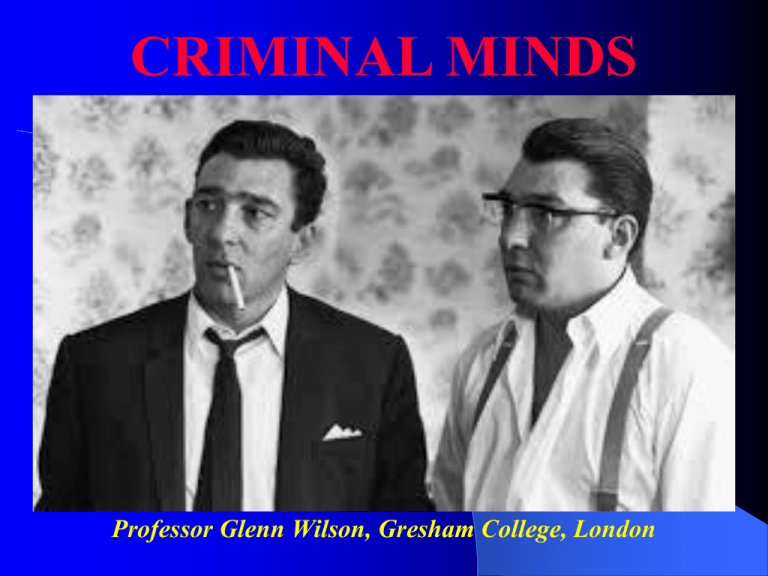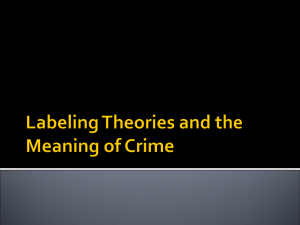
CRIMINAL MINDS
Professor Glenn Wilson, Gresham College, London
WHAT IS CRIME?
Crime is distinguished from vice.
Activities aimed at satisfying personal
desires, without malice, are not
consistently outlawed. Prostitution,
pornography, drug-taking, gambling,
abortion & euthanasia may be immoral
and degrading but are only indictable in
some times/places.
Murder, burglary, assault, robbery & rape
involve intent to harm and are crimes in
virtually all societies.
Anti-vice laws are often counterproductive, “the cure being worse than the
disease”.
Decriminalisation of homosexuality,
pornography, adultery, prostitution &
abortion in many countries did not result
in the social chaos some feared.
Prohibition in the US (192033) was a “failed experiment”
resulting in massive corruption
and the rise of gangsters like
Al Capone.
RISK FACTORS
A great many risk
factors (preceding
characteristics) have
been identified for
delinquency and crime.
Some apply mostly to
one gender (Day &
Wanklyn, 2013).
Generally unsurprising
correlates telling little
about cause and effect.
e.g., Parental separation,
conflict and
maltreatment may be
causes but could equally
reflect genetic
transmission of
antisocial traits.
CRIME AND POVERTY
Popular belief that crime is due
to poverty/deprivation is not
supported.
UK crime increased most sharply
between 1950 and 1970, when
we “never had it so good”. It is
now declining despite
“austerity”.
Relative poverty correlates
inversely with crime rates within
and across nations (Fraser, 2011).
Social problems of all kinds
congregate within
neighbourhoods but one does not
necessarily cause the others.
Looting in the 2011 London riots targeted luxury
goods such as electronics and designer trainers,
not necessities.
Envy, entitlement and excitement seem more
explanatory than poverty and deprivation.
UNEMPLOYMENT
Widely believed that
unemployment causes
crime but again
connection is unclear.
Petty criminals are
more likely to be out
of work than noncriminals but
evidence that changes
in levels of
unemployment affect
crime rates is lacking.
During Hugo Chavez’
rule in Venezuela
(1999-2013)
unemployment halved
while the murder rate
Official US figures for unemployment and crime show
tripled.
minimal relationship.
PERCEIVED UNFAIRNESS
A radical egalitarian culture
promoting the view that
inequality is illegitimate has
been suggested as a crime
factor but this idea is not
supported across nations
(Stack, 1984).
Wage discrepancies in the
US have increased in recent
decades. What could matter
is rubbing shoulders with
richer people, thus raising
awareness of inequity.
Ethnic mixes and income
differentials within local
neighbourhoods in the US
do seem to increase crime
(Hipp, 2007).
MORAL COMPASS
The Cambridge Institute of
Criminology followed 700
Peterborough youth over a
decade (Wickstrom et al,
2012).
A tiny band of 4% were
responsible for half of all
offending (averaging 278
crimes by age 16). They were
versatile in their offending,
regularly committing burglary,
theft, violence and vandalism.
They admitted having no
conscience or self-control.
The majority who were lawabiding did not lack
opportunity or fear the
consequences but saw crime as
“morally wrong”.
CONSCIENCE FAILURE
Eysenck (1964) theorised that
criminality was associated
with poor fear conditioning (=
weak conscience).
Gao et al (2009) studied 1795
Mauritian children, measuring
electrodermal conditioning at
age 3. At age 23, 137 of the
cohort who had acquired a
criminal record were
compared with 274 noncriminals, matched for sex,
ethnicity and social adversity.
The criminal group showed
deficient fear conditioning.
The authors implicate the
amygdala and prefrontal
dysfunction in children who
grow up to be criminals.
ABSENT FATHERS
In some parts of UK, the majority
of households are single-parent
(mainly mother). Suggested that
lack of male role model increases
crime but non-correlational
evidence is hard to obtain.
Bambico et al (2013) raised
California mice (normally
monogamous and biparental)
without fathers. Deprived mice
(but only females) showed social
deficits and increased aggression also structural changes in the
medial prefrontal cortex.
Consistent with human studies
showing father-deprived
daughters are more susceptible to
drug abuse.
TV VIEWING
Time spent viewing TV in
childhood (ages 5-15 years)
is associated with antisocial behaviour, aggression
and crime in young
adulthood. True for both
males and females and after
controlling for IQ & social
class (Robertson et al,
2013).
Again, a longitudinal study
consistent with a causal
relationship but other
possible mediating factors
(e.g., antisocial parents;
disobedience of parental
attempts to limit viewing.)
LEAD POISONING
Crime has fallen since
lead was removed
from petrol and paint .
Environmental lead is
shown to impair IQ
and increase ADHD.
Bone lead is linked to
various forms of crime
& delinquency (Nevin,
2000).
Persuasive, but falling
crime could be due to
many other factors
(e.g., aging population,
tougher policing,
increased
incarceration).
In 6 US cities air Pb “explained” 90% of
variance in aggravated assaults 22 years later
(Mielke & Zharan, 2012).
SECURITY DEVICES
Opportunity is a major factor in
crime - it flourishes when made
easy. Some types are falling
because modern technology has
made them difficult (Farrell, 2013).
Car theft plunged with
sophisticated alarms, immobilisers,
trackers and automatic number
plate recognition.
Burglar alarms, DNA analysis,
CCTV and mobile phone location
increase the likelihood of burglars
getting caught (a major deterrent).
Many household items once
valuable are now hardly worth
stealing (DVD players etc).
Some new types of crime are
increasing (card fraud, web scams).
BEING WATCHED
CCTV and other security
devices have helped in
crime deterrence and
detection but have also
altered clothing favoured
by criminals (hoodies)
and may deflect crime to
other places.
Signs at a university
campus warning bicycle
thieves they were being
watched led to a 62%
decrease in theft nearby
but a 65% increase at
control locations (Nettle
et al, 2012).
PRE-CRIME FORECASTS
Computer modelling of crime patterns helps police deploy resources to
locations likely to be targeted by criminals, esp. for burglary, mugging
& car theft (Hering & Blair, 2014).
Hotspots are not identical to past occurrences. Near repeats are more
common (e.g., houses close to those recently burgled). Burglars seem
to act like wild animals looking for food – returning to sites previously
found productive but moving on when these are exhausted.
ZERO TOLERANCE
Crackdowns on minor offences
like graffiti, vandalism and faredodging appear to reduce crime
across the board. Techniques
include police presence in
trouble spots and roadside
checks on cars. Even mending
broken windows may help to
reclaim the streets from gang
control.
Approach appeared to work in
1990s New York and was
copied in other US cities (also
Liverpool under Bernard HoganHowe).
Reputation for toughness is
important within gangs members often commit crimes
for status-enhancement. Making
it “tough” to get away with
minor offences reduces the need
to commit major crimes (Dur &
Van der Weele, 2013).
Falls in NY violent crime were impressive under
Mayor Giuliani but had begun earlier.
CRIMINAL GENES
Twin studies show that criminality
is genetically influenced, esp.
lifetime criminality (heritability
estimates ranging from 40-70%). In
the US, 5% of families account for
half the arrests - partly due to genes
and partly mating patterns (Beaver,
2013).
Adoption studies find criminal
behaviour (esp. burglary) relates
more strongly to biological father
than foster father (Mednick et al,
1984).
The adoptive environment also has
an effect on criminal behaviour additive with genetic effect
(Kendler et al, 2013)
Dopamine genes that increase risk
of violent crime (DAT1, DRD2,
DRD4) are more common in
neighbourhoods that are poor and
violent (Barnes et al, 2013).
PERSONALITY AND CRIME
Relationship between genes and
crime is probably mediated by
personality traits.
Thrill-seeking, aggressiveness,
impulsiveness and negative
emotionality go with criminality;
also low agreeableness &
conscientiousness (Reid, 2011).
Applies for both men and
women but some traits are more
pronounced in men, hence male
preponderance of crime.
Different types of crime are no
doubt associated with different
personality profiles. Fraud tends
to go with arrogance,
psychopathy and higher IQ than
burglary.
ADHD AND CRIME
Attention Deficit-Hyperactivity
Disorder is a controversial condition,
- concern about over diagnosis and
treatment. Still a behavioural
problem associated with crime (3040% of long-term criminals may
have ADHD).
Large-scale Swedish study (25,656
patients): those on medication
showed a reduced crime rate over 4
years (32% for men, 41% for
women).
Reductions applied to various types
of drug (stimulant and nonstimulant) and serious as well as
petty crimes.
Treatment compliance may have
partly mediated these effects but
result is still noteworthy.
PSYCHOPATHY
Psychopathy is a personality disorder
characterised by lack of empathy,
impulsiveness, sensation-seeking,
manipulative and antisocial
behaviour.
More common in criminals (around
15-20%) but many non-criminal
people also show psychopathic traits
(business executives & bomb
disposal more than caring professions
like nursing).
Psychopathy is connected with overactivity in dopamine reward system
(approach tendencies) and underfunctioning of prefrontal brain areas
concerned with moral restraint and
pro-social emotions like guilt and
embarrassment (Gregory et al, 2012).
The nucleus accumbens (depicted) is part
of the dopamine reward system that is
often over-active in psychopaths.
THE LOOK OF A CROOK
Criminals can be distinguished
beyond chance from non-criminals
from headshots alone (even after
controlling for gender, race, age,
attractiveness and emotional
expression).
Cues unclear but may be signs of
masculinity.
Different types of criminal (theft,
murder, arson, rape, forgery, etc) not
distinguished. Fits with fact that
criminals do not specialise (most
commit several types of crime).
Exception: women poor at spotting
rapists (inclined to see them as noncriminal). Rapists seem to have
evolved “camouflage” enabling them Sample of stimuli used by Valla et al
to get close to women.
(2011). 3 = rape, 4 = assault, 5 = arson,
1,2,6 = non-criminal
IS CRIMINALITY ADAPTIVE?
Psychopathy may not be
“dysfunctional” but an evolved
life strategy with genetic
benefits that outweigh the
disadvantages.
Krupp et al (2013): evidence
that their violence is nepotistic
(directed mainly against
unrelated people).
Psychopaths are often attractive
to women. Lynn (1995) found
that criminals have higher
fecundity (avge 3.91 children vs
2.21 for non-criminal controls
from same social class/urban
residence). Dysgenic forces
Nikko Jenkins, who killed 4 people in a
may contribute to criminal
shooting spree, is one of an Omaha family of
behaviour.
38 descendants of the same man responsible
for 633 crimes since 1979.
COMPULSIVE CRIME?
Armed robber Trevor Hayes was
serving an indefinite term in prison
when a brain tumour was discovered
in his frontal lobe that might have
caused his aggressiveness. (His
previous record was mostly petty
theft).
Defence lawyers argued that
following surgery he was no longer
dangerous. Judge in London’s
Appeal Court reduced his sentence to
11 years, saying that Hayes still
“knew what he doing was wrong”.
In Italy, a murderer had his sentence
reduced because he carried 5 genes
associated with violence (Feresin,
2009). Illogical because this
defendant would be just as dangerous
after release.
NEUROCRIMINOLOGY
In The Anatomy of Violence ,
Raine (2013) says murderers may
be identified by brain scans
showing underactivity in the
prefrontal cortex. This implies
poor control of limbic regions that
generate anger and violence.
Psychopaths often have a small
amygdala and an exceptionally
low heart rate.
Epigenetics also important and
environmental factors like child
neglect & abuse, poor nutrition,
prenatal smoking & drinking
contribute to development of
criminal brains.
PET-scan evidence presented in court by
Raine helped murderer Donta Page escape
the death penalty.
PREDICTING REOFFENSE
Error-related fMRI
activity in the anterior
cingulate cortex
recorded during an
impulse-control (go/nogo) task predicted
rearrest within 4 years
of release in a group of
96 US offenders. The
odds of an offender with
low ACC activity being
rearrested were double
those of high ACC
activity (Ahoroni et al,
2013).
This measure is not
sufficiently accurate for
making life-altering
individual decisions.
RECIVIDISM
According to Ministry of Justice
figures, 1 in 3 UK criminals is a
serial offender with at least 15
previous convictions. Only 10% of
those cautioned or convicted in the
UK 2012 were first-time offenders
(Salkend, 2013).
This is commonly said to show that
“prison does not work”. What it
really shows is that short sentences
are ineffective. The public is
protected for the time the criminal
is in prison.
Criminals on bail commit a crime
every 10 minutes, including 2 rapes
per week & 1 in 7 murders (Doyle
2013).
Shoplifter Robert Knowles (66) has
been in court every year since 1959.
Last year, following his 330th
conviction, he was jailed for 4
months but immediately released
because of time spent in custody.
“THREE STRIKES” LAW
25 US States have
introduced a “3 strikes
and you’re out” law - a
3rd felony offence
incurring a mandatory life
sentence. Inflexibility has
led to many anomalies draconian sentences for
minor infringements.
Scheme is costly in
raising prison populations
and largely ineffective as
deterrent.
Even a slight increase in
murder due to criminals
having nothing further to
lose (c.f., death penalty). Kovandzic et al (2004) found no obvious reduction
in crime levels under US “3-strike” laws. Crime
Some 2nd strikers are
prompted to move State. rates in non-participating States declined similarly.
WHAT IS PRISON FOR?
Imprisonment rates have increased in recent
decades but purpose is unclear.
Some think punishment but prison,
however unpleasant, is an oblique and
wasteful method.
Some say deterrence but prison is little
feared by career criminals and may actually
be a “school for crime”.
Rehabilitation ?- prison is stigmatising,
breaks family ties and fails to prevent
reoffending (Pritikin, 2008). Drugs and
unprotected sex (often coercive) are rife in
prison and suicide rate raised 10x.
Retribution is immature; often based on
outcome, not intent of behaviour.
Containment of people who are dangerous
to the community is perhaps the only proper
use of prison; may apply to a minority of
people currently imprisoned prison.
Vicky Price was jailed for
perjury after taking her
husband’s “speeding points”.
She was not dangerous and
might have been punished in
other ways.
COMMUNITY SERVICE
A good alternative to prison when
offenders are not dangerous is
community service.
This has elements of punishment
(deprivation of free time), reparation
(payback) and rehabilitation
(maintaining family ties and promoting
a work ethic).
Although humiliating, it is more
civilised than prison, and less
expensive (though supervision is
required). It is superior to prison in
reducing recidivism (Vogelgesang et
al, 2010).
Probation with electronic tagging can
also be effective (Killias et al, 2010)
but offers no payback to the
community.
Footballer Joey Barton was sentenced
to 200 hrs community service for
assault. Others include Vinnie Jones,
Mike Tyson & Boy George.
LEOPARDS AND SPOTS
Rehabilitation is difficult for many
criminals, especially those who are
psychopaths.
Despite being more likely to reoffend,
psychopaths often charm their way to
early release (Porter et al, 2009).
There is ongoing debate as to whether
psychopaths are treatable (Wilson &
Tamatea, 2013) and whether they are
morally responsible, or themselves
victims (Glenn et al, 2013).
Developments in neurocriminology
raise questions as to whether concepts
like “free will” and “culpability” have
any usefulness in a forensic context.
Criminal intent and future risk are what
really matter.










